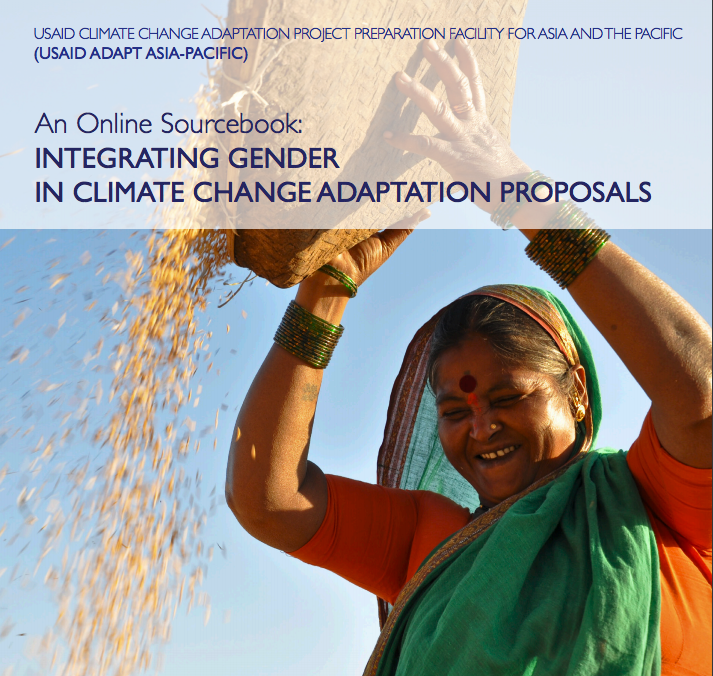An Online Sourcebook: Integrating Gender in Climate Change Adaptation Proposals

Introduction
The impacts of climate change – drought, floods, extreme weather, and reduced food and water security – severely affect the most vulnerable groups, particularly women who are often dependent on the natural resources threatened by environmental change. But while women are disproportionately impacted, they have a unique and essential contribution to make in adapting to a changing climate, as many women manage water, food and fuel for their families.
The online Gender Sourcebook enables project proponents to design gender-responsive climate change adaptation measures as well as projects, particularly in developing countries, by providing targeted, sector-specific guidance and real-life examples that are easy to follow and navigate on laptops and mobile devices.
Go to the Gender Sourcebook
The Sourcebook is a live document that will be periodically updated. A pdf version is available to download from the right-hand column.
Institutional Background
The Gender Sourcebook was developed by USAID Adapt Asia-Pacific and launched in 2014. USAID Adapt Asia-Pacific also produced Gender and Climate Change Adaptation: A flexible training package with ICCCAD, which can be applied in various short courses and workshops.
Who is this for?
The Sourcebook is intended to be used mainly by individuals and teams who prepare large-scale climate change adaptation (CCA) project proposals. The sourcebook covers major development sectors affected by a changing climate, including agriculture, coastal management, biodiversity conservation, energy, and transportation. Overall, it provides readers with tools to help answer the question, “How do we best go about incorporating gender considerations into our CCA proposal?”
We understand that Sourcebook readers will come from a wide array of backgrounds, including:
- Gender specialists
- CCA specialists
- Engineers
- Economists
- Others
Users will find that each section of the sourcebook is self-contained, allowing you to go directly to those sections, tools, and sectors of particular relevance to your work. The sourcebook also provides tailored entry points that cater for specialists and non-specialists:
| for Gender/Climate Change Specialists |
In the Gender Sourcebook
Each section of the Sourcebook is self-contained. Simply click the appropriate link above for an introduction to the Sourcebook sections which may be particularly applicable to you. Alternatively, as a general guide, we have suggested below sections of the Sourcebook that may be particularly useful to readers.
Gender Sourcebook Section Guide
- Background, key assumptions and glossary
- Sections 3–5 describe the background (for specialists and non-specialists) for the development of the Sourcebook (Section 3) and the key assumptions made about CCA proposal preparation and gender mainstreaming (Section 4), and offer a glossary of terminology used in the Sourcebook (Section 5). Readers less familiar with gender issues may want to review the glossary before reading other sections.
- Summary checklist and key topics
- Section 6 provides a summary checklist for addressing gender (Table 1) within typical CCA proposal sections, as well as summarizing gender-related data needs and monitoring, and providing links to gender tools. This information is framed by the requirements and guidance available for six multilateral climate funds.
- Section 7 summarizes key gender analysis topics for climate-relevant sectors and recommends entry points and indicators. The sector modules covered are agriculture; forestry/watershed management; biodiversity conservation; coastal water resources and fisheries; water, sanitation and hygiene; health; energy; transport; and urban programs.
- Case studies
- Section 8 offers 10 concise case studies of gender mainstreaming for each of the priority sectors from Section 7.
- Integrating gender-sensitive Terms of Reference and Stakeholder Analysis
- Section 9 provides ToRs for both international and host country gender specialists for different types of CCA assignments to collect gender-related data or influence decision-making processes.
- Section 10 is drawn from an existing resource that highlights when to use a Gender-Sensitive Stakeholder Analysis. Sources for other gender methodologies are referenced in Section 6.
- Resources and references
- In Section 11, the CCA-relevant gender resources from international and Asia-Pacific regional sources, are presented in Table 16 so that a proposal writer can easily find a source of sectoral or country-specific gender information.
- The Sourcebook bibliography is presented in References.
Funded through USAID’s Regional Development Mission for Asia (USAID/RDMA) and implemented by AECOM, USAID Adapt Asia-Pacific was designed to share information and best practices about climate change adaptation finance modalities and project preparation tools and help governments build capacity to access the existing pool of international climate change adaptation funds.
Go to the USAID Climate Change Adaptation Project Preparation Facility for Asia and the Pacific (USAID Adapt Asia-Pacific) project page
Authors
Dr. Nancy K Diamond and Dominique Lellement
Suggested Citation
USAID Adapt Asia-Pacific (2014) An Online Sourcebook: Integrating Gender in Climate Change Adaptation Proposals. USAID Regional Development Mission for Asia: Bangkok, Thailand.
(0) Comments
There is no content